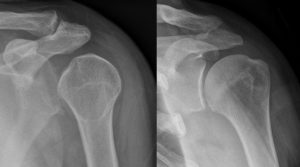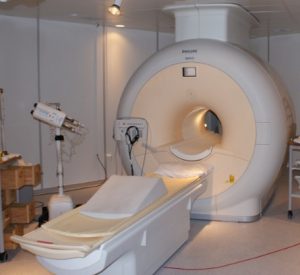When it comes to problems with the musculoskeletal system, shoulder issues (including shoulder pain) are some of the most commonly-reported problems. Sometimes shoulder pain is temporary, but long-term problems require diagnosis and treatment by medical professionals.
The shoulder is a remarkable joint; it has the widest range of motion in the body. This versatility comes at a price, and shoulders are fairly fragile. Joint injuries are all too common. Additionally, relatively minor injuries to the shoulder can lead to ongoing degeneration and more significant dysfunctions over time.
Pain in the shoulder can come from a problem with the joint itself or from issues with any of the many muscles, ligaments, and tendons connected to the joint. Joint-related shoulder pain typically becomes worse as you move or stress your arm and shoulder. There are also other medical issues that can cause shoulder pain symptoms, including heart disease and gallbladder disease. When shoulder pain is caused by an outside influence like this, it’s called a “referred” pain. Referred shoulder pain is unaffected by how much movement and activity you subject the joint to.
The Most Common Symptoms of Shoulder Pain
- Aching pain
- Redness
- Swelling
- Tenderness
- Mobility impairment
- Weakness
- Sensitivity to temperature
- Warm sensations in the area of the joint
The Causes of Shoulder Pain
Shoulder pain can be caused by injuries, chronic health conditions, or poor posture. Examples of common causes include:
- Overexertion damage
- Tendonitis arising from overuse
- Joint instability
- Bone fractures of the upper arm or collar bones
- Dislocation
- Nerve pinches (aka radiculopathy)
- Separation
- Frozen shoulder
- Disease or injury affecting the rotator cuff
- Fractures
- Bone spurs
- Arthritis
In some cases, pains felt in the shoulder are actually being caused by a medical issue in another part of the body entirely, like the lungs, neck, or gallbladder. This is known as referred pain. Referred shoulder pain is unaffected by movement of the shoulder joint.
How Do Doctors Diagnose Shoulder Pain?
Doctors begin examining shoulder pain by asking you questions about what you’re experiencing. A basic physical examination is also a common first step. Your doctor will look for any visual differences between your shoulders, including swelling, bruising, redness, and evidence of dislocation. The doctor may also manipulate your shoulder to see if there are specific movements that cause your pain to worsen.
Following his or her initial diagnosis, your doctor may also want to perform some or all of the tests listed below:
X-rays
Ordinary x-rays can reveal problems like bone damage, signs of arthritis, or a narrowing of the space between the bones in the shoulder joint.
MRI
Magnetic resonance imaging is a non-invasive technique for visualizing the structure of the shoulder joint in great detail.
Blood Work
Your doctor may use basic blood tests to rule out polymyalgia rheumatica (PMR) and other inflammatory conditions.
How Shoulder Pain is Treated
Shoulder pain, like other forms of chronic pain, can be treated in a host of different ways. A thorough diagnosis is required before your doctor can lay out an effective treatment regimen. Picking treatment options should only proceed after the cause of your shoulder pain has been accurately identified. For some severe shoulder pain cases, surgical repair is the only viable way to relieve the pain and restore healthy functionality to the joint. Listen to your doctor’s advice on how to best treat your shoulder pain.
Milder cases of shoulder pain may attract a recommendation of home remedies from your doctor. This is typically an intermediate step designed to seek relief without relying on prescription medication. Home treatment of shoulder pain symptoms can take up to six weeks to work, or even longer. Neck and shoulder pains rooted in the soft tissues are usually treated with anti-inflammatory over-the-counter medications. Examples include ibuprofen (Advil or Motrin) and naproxen (Aleve or Naprosyn). Your doctor may also recommend pain relievers such as acetaminophen (Tylenol). In certain cases, doctors may prescribe diverse medications including muscle relaxers and even antidepressants.
The most common steps for the initial treatment of shoulder pain can be recalled using the mnemonic acronym RICE – Rest, Ice, Compression, Elevation.
Rest
Take at least 48 hours of rest while you protect the injured area from all stress and motion. Alter your behavior as necessary to avoid subjecting your injured shoulder to any strain.
Ice
Applying ice serves to minimize swelling and pain. Apply cold packs or ice as soon as you notice the pain. Keep the area cold for 10 to 20 minutes at a time, repeating the treatment 3 times a day or more frequently. For at least 48 hours, avoid any high temperatures or anything else that might increase swelling (hot showers, hot packs, alcoholic beverages). You can transition from cold treatment to hot treatment after two to three days as long as the swelling is gone. Moist heat is ideal for eliminating stiffness and restoring function. According to some professionals, alternating between heat and cold may help you recover faster.
Compression
Applying even pressure to the affected area will also help reduce swelling. Use a bandage or wrap to hold the shoulder in a comfortable position. Rubbing and gentle massage will help mitigate pain and encourage better blood flow. Do not use massage if it causes increased pain.
Elevation
Rest in a position that keeps your injured shoulder higher than your heart. Propping it up on a pillow is a good idea. Wear a sling for at least 48 hours following a shoulder injury to give the joint added support. If it feels better to continue using the sling after more than 48 hours have passed, get your shoulder examined by a doctor.
Exercises for Shoulder Pain
You may find the following exercises helpful. Speak to your doctor about other forms of physical therapy as well.
Range Of Motion
From a standing position, lean down facing the floor. Let the affected arm dangle limply straight down. Use it to draw circles in the air. Start with small ones and slowly expand the size. Repeat this process five to 10 times every day. Stop exercising if you experience fresh shoulder pain; you can resume your therapy later.
Rotator Cuff Strengthening
This process requires a short length of rubber tubing. Stand next to a closed door with an ordinary doorknob. Loop your tubing around it. Bend the arm closest to the door 90 degrees at the elbow and grasp the tubing. Pull the rubber across your belly. Start with completing a single set of 10 pulls. As your shoulder heals, try to build up the number of sets you complete every day.
Upper Extremity Strengthening
As your shoulder pain recedes, try to start strengthening the area using a general upper body strength training regimen. Weight machines are helpful, but you can also use free weights. Lie on the right side of your body with your left arm on your hip. Keep your forearm across your belly with a weight gripped in your left hand. Raise your forearm with your elbow held close to your side.
When You Should See a Doctor?
Sudden shoulder pain is a potential symptom of a heart attack. If you experience crushing pain or sudden pressure in your shoulder, call 911. If the pain extends from your chest to your jaw, neck, and arm, a heart attack is especially likely. Further symptoms include sweating, dizziness, and shortness of breath.
Get to an emergency room immediately if you experience a shoulder injury that causes extreme pain, bleeding, bruising, and/or swelling.
If you suspect a pinched nerve, it’s extremely important to get the issue diagnosed and start treatment sooner rather than later. Ignoring the problem can lead to neuropathy or permanent nerve damage.
Conclusion
Because the shoulder is a very mobile, very frequently-used joint, the risk of damaging it is good. Shoulder pain can be caused by a variety of conditions. It can be treated with a range of options from simple at-home care to more intensive medical techniques (i.e. intra-articular peripheral joint injection). Speak to your doctor about the benefits and drawbacks of each method of treating shoulder pain.






